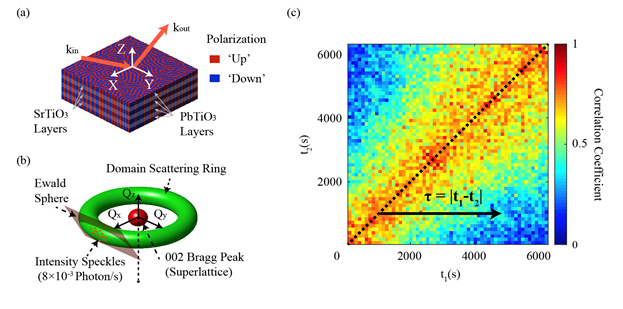Ferroelectrics refer to materials with spontaneous electric polarization that can be switched by external electric fields. They are very similar to magnets but with electric instead of magnetic polarization. Besides their widespread applications in piezoelectric nanopositioners and ferroelectric RAMs that make use of the net ferroelectric polarization, the spatial arrangements of polarization domains in nominal atomic layers of ferroelectrics are also considered for high-density information storage due to their well-defined spatial structures with characteristic lengths as small as a few nm. The stability of the domain structures is therefore key to the design of non-volatile memories. However, tracking the domain motion in real time is extremely challenging as it requires detecting sub-angstrom atomic fluctuation on a nanometer spatial scale at elevated temperature. Researchers using the U.S. Department of Energy’s Advanced Photon Source (APS) overcame this obstacle with their study of serpentine striped ferroelectric nanodomains in a ferroelectric/dielectric superlattice. Ferroelectric polarization ordering is a promising candidate for self-assembly growth next-generation information storage, so their results provide a quantitative approach for measuring the stability of these structures, providing essential information for both modeling and application of complex ferroelectric oxides in a variety of technologies.
The group of researchers investigated the temperature dependence of the equilibrium dynamics of ferroelectric nanodomains in a ferroelectric/dielectric PbTiO3/SrTiO3 superlattice using wide-angle x-ray photon correlation spectroscopy (XPCS) at the X-ray Science Division 8-ID-E beamline at the APS, an Office of Science user facility at Argonne National Laboratory. With the XPCS technique set to resolve atomic scale wave-vectors, the domain motion was recorded in a movie of coherent x-ray scattering patterns from the domains. The temporal decorrelation of the intensity speckles in the coherent scattering patterns revealed the time-scale of the domain dynamics. Fig. 1c shows the two-time correlation function of speckle patterns collected at time t1 and t2. Speckle patterns decorrelate as a function of time delay |t1 - t2|, and the process is in equilibrium as this decorrelation time is constant along the dashed line t1 = t2. This decorrelation time was measured from correlation functions performed at increasing temperatures.
Alternating atomic layers of PbTiO3 and SrTiO3 preserved the nanoscale spatial order of ferroelectric domains and provided additional robustness for the domain structures. The characteristic length scales are 6 nm for the domain periodicity and 30 nm for the in-plane coherence of the domain pattern. Spatial disorder in the domain pattern gives rise to coherent hard x-ray scattering patterns exhibiting intensity speckles.
Variable-temperature Bragg-geometry XPCS reveals that x-ray scattering patterns from the disordered domains exhibit a continuous temporal decorrelation due to spontaneous domain fluctuations. The temporal decorrelation can be described using a compressed exponential function, consistent with what has been observed in other systems with arrested dynamics. The fluctuation speeds up at higher temperatures and the thermal activation energy estimated from the Arrhenius model is 0.35 ± 0.21 eV. This energy barrier is smaller than both the activation energy for the migration of oxygen ion vacancies (a common domain wall pinning mechanism in ferroelectric perovskites) and the energy required to change the directions of domain walls as predicted from first-principle simulations.
The researchers suggest that the complicated energy landscape of the domain structure is induced by pinning mechanisms, and domain patterns fluctuate via the generation and annihilation of topological defects, a mechanism that requires little change of the system free energy and is commonly seen in soft materials such as block copolymers. The future APS Upgrade will enable such studies with much higher time and spatial resolution, probing these fluctuations on submillisecond time scales with beams smaller than 500 nm.
See: Qingteng Zhang1, Eric M. Dufresne1, Pice Chen1, Joonkyu Park2, Margaret P. Cosgriff2, Mohammed Yusuf3, Yongqi Dong1,4, Dillon D. Fong1, Hua Zhou1, Zhonghou Cai1, Ross J. Harder1, Sara J. Callori3, Matthew Dawber3, Paul G. Evans2, and Alec R. Sandy1*, “Thermal Fluctuations of Ferroelectric Nanodomains in a Ferroelectric-Dielectric PbTiO3/SrTiO3 Superlattice,” Phys. Rev. Lett. 118, 097601 (2017). DOI: 10.1103/PhysRevLett.118.097601
Author affiliations: 1Argonne National Laboratory, 2University of Wisconsin-Madison, 3Stony Brook University, 4University of Science and Technology of China
Correspondence: *[email protected]
Work on the reference sample for the calibration of the setup stability was supported by U.S. Department of Energy (DOE) Office of Science-Basic Energy Sciences, Materials Sciences and Engineering Division. Work at the University of Wisconsin-Madison was supported under Grant No. DE-FG02-10ER46147 (P. E.). Work at Stony Brook University was supported by the U.S. National Science Foundation, Division of Materials Research under Grant No. 1055413 (M. D.). This research used resources of the Advanced Photon Source, a U.S. DOE Office of Science User Facility operated for the DOE Office of Science by Argonne National Laboratory under Contract No. DE-AC02- 06CH11357.
Argonne National Laboratory seeks solutions to pressing national problems in science and technology. The nation's first national laboratory, Argonne conducts leading-edge basic and applied scientific research in virtually every scientific discipline. Argonne researchers work closely with researchers from hundreds of companies, universities, and federal, state and municipal agencies to help them solve their specific problems, advance America's scientific leadership and prepare the nation for a better future. With employees from more than 60 nations, Argonne is managed by UChicago Argonne, LLC for the U.S. Department of Energy's Office of Science.
The U.S. Department of Energy's Office of Science is the single largest supporter of basic research in the physical sciences in the United States and is working to address some of the most pressing challenges of our time. For more information, visit the Office of Science website.

